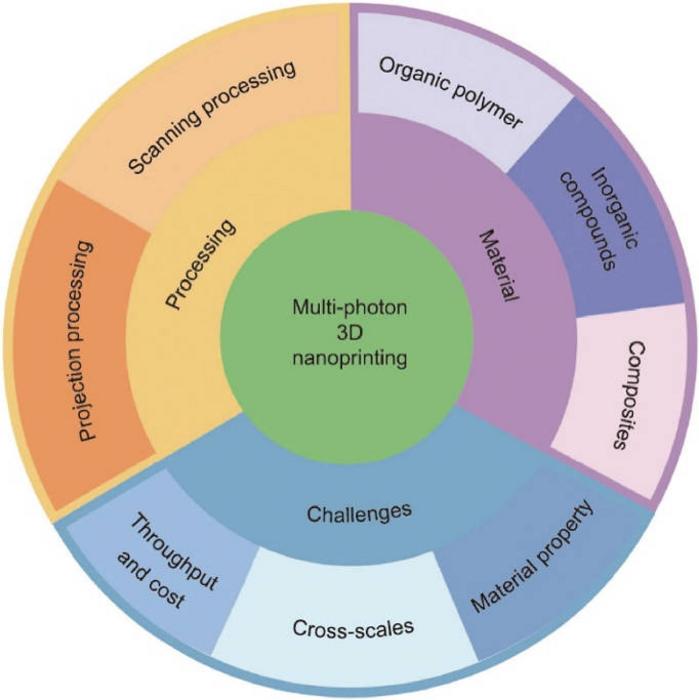Recent advancements in multi-photon 3D nanoprinting embody a significant leap forward in the field of micro/nano-additive manufacturing. This innovative technique has garnered attention for its extraordinary capabilities, enabling 3D processing at nano-scale resolutions that far exceed the limits imposed by diffraction. The intricate interplay of light and matter in multi-photon absorption allows for unparalleled precision in the fabrication of complex three-dimensional structures. As researchers dissect its potential applications, multi-photon 3D nanoprinting emerges as a vital asset across varied domains including optics, biology, and mechanical engineering.
In optics, the technology has reshaped conventional design paradigms by facilitating the creation of optical lenses with sub-nanometer precision. This enhanced resolution is crucial for developing advanced instrumentation and photonic devices. Researchers are actively exploring ways to leverage the exceptional capability of multi-photon 3D nanoprinting to tailor optical elements with customized refractive properties, thereby breaking through the limitations of traditional lens manufacturing processes. For instance, intricate designs previously unprecedented in lens architecture can now be achieved, potentially unlocking a new realm of capabilities in imaging systems and telecommunications.
In the biomedical sector, the significance of multi-photon 3D nanoprinting is becoming increasingly evident. The ability to fabricate intricate microstructures has opened new avenues for cell research, enabling scientists to create customized environments for studying cellular behaviors. Additionally, this technology is paving the way for innovative drug delivery systems where the precise placement of therapeutic agents can dramatically enhance treatment efficacy. The synthesis of bio-compatible materials in conjunction with multi-photon techniques leads to the potential for constructing complex, functional biomaterials tailored to specific medical applications.
Despite its promising capabilities, multi-photon 3D nanoprinting faces critical hurdles that must be conquered to expand its utility in commercial settings. A primary obstacle is the processing speed, which currently remains relatively slow. This limitation is a considerable barrier to large-scale industrial adoption. Researchers are aware that understanding and enhancing the throughput of multi-photon 3D nanoprinting systems is indispensable. Consequently, there is a burgeoning interest in developing projection-based processing technologies that promise improved performance through faster light distribution across the printed object.
On the flip side, point-scanning-based processing technologies such as random-access and raster scanning have evolved to provide higher resolutions, albeit at the expense of processing speed. Researchers have been exploring ways to increase the number of foci in random-access scanning, which has reported enhancements in parallel processing efficiency. Furthermore, the development of more advanced scanning devices, including galvanoscanners, resonant scanners, polygon scanners, and acousto-optical scanners, is expected to augment the performance of raster scanning. These innovations may close the speed gap and allow point-scanning technologies to be more competitive in the landscape of multi-photon nanoprinting.
Composites present a relatively new opportunity within this domain, yet they face challenges in achieving a uniform and concentrated dispersion of dopant materials. Ensuring the right material combination that balances functionality with manufacturability remains a prominent research focus. As experts refine material systems, innovative approaches will offer the potential for advancing the reliability and scalability of multi-photon 3D nanoprinting.
The road ahead for multi-photon 3D nanoprinting signals a bright future, contingent upon research innovations that seek to increase throughput by orders of magnitude and enhance cross-scale processing techniques. The goal is to streamline workflows and bridge the gap between nanoscale fabrication and practical applications across industries. The synergy of technological advancement in processing methodologies and materials science is set to propel this sophisticated technology to an unrivaled status in manufacturing and biomedical applications alike.
Ongoing research and continuous dialogue within the scientific community will be instrumental in overcoming the current limitations. With a collective pursuit of excellence and innovation, the ultimate aim is not merely to refine multi-photon 3D nanoprinting techniques, but to harness their full potential for transformative industrial applications. As challenging obstacles are dismantled, multi-photon 3D nanoprinting stands poised to redefine the landscape of modern manufacturing, creating unprecedented opportunities across technological spectra.
Through the steady march of innovation, we anticipate that multi-photon 3D nanoprinting will soon establish itself as an indispensable tool not only in laboratories but also in commercial production lines. This technology might one day become a foundational element in a myriad of sectors, merging diverse scientific disciplines, and pushing the boundaries of what can be achieved in fabrication and material science.
While the journey is fraught with complex challenges, the promise of multi-photon 3D nanoprinting remains undeniably potent. As researchers refine both the methodologies and materials involved, the future prospects for this fascinating area of study look to be fruitful, leading the way toward advancements that truly resonate with the future of manufacturing and beyond.
Subject of Research: Multi-photon 3D nanoprinting technology and its applications.
Article Title: Recent Advances and Challenges in Multi-photon 3D Nanoprinting
News Publication Date: 3-Dec-2024
Web References: https://doi.org/10.1016/j.eng.2024.09.028
References: None
Image Credits: Fayu Chen et al.
Keywords: multi-photon 3D nanoprinting, micro/nano-additive manufacturing, optical lenses, biomedical applications, material limitations, processing speed, projection-based technologies, scanning devices, composites, drug delivery systems.
Tags: 3D nanoprinting technologyapplications in biomedical engineeringbreakthroughs in photonic deviceschallenges in nanoprinting scalabilitycomplex 3D structure applicationscustomization of optical elementsfuture directions in multi-photon technologyinterdisciplinary applications of nanoprintingmicro-additive manufacturing advancementsmulti-photon absorption techniquesoptical lens fabrication innovationsprecision in 3D structure creation





